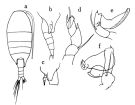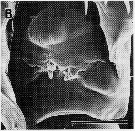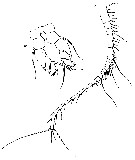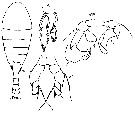|
|
 |
Fiche d'espèce de Copépode |
|
|
Calanoida ( Ordre ) |
|
|
|
Arietelloidea ( Superfamille ) |
|
|
|
Nullosetigeridae ( Famille ) |
|
|
|
Nullosetigera ( Genre ) |
|
|
| |
Nullosetigera bidentata (Brady, 1883) (F,M) | |
| | | | | | | Syn.: | no Phyllopus bidentatus : Wolfenden,1904 (p.124, fig.M); Farran, 1905 (p.45); Esterly, 1905 (p.191, figs.F);
no Phyllopus bidentatus : Giesbrecht, 1892 (p.419, 774, figs.F); Giesbrecht & Schmeil, 1898 (part., p.124);
Phyllopus bidentatus Brady, 1883 (p.78, figs.F, no M); T. Scott,1894 (part., p.74); Norman, 1903 b (p.138, Rem.); I.C. Thompson, 1903 a (p.29, figs.M); Cleve, 1904 a (p.194); Pearson, 1906 (p.29); A. Scott, 1909 (p.147, figs.F,M); Esterly, 1911 (p.336-337: Rem.); Lysholm & Nordgaard, 1921 (p.27); Wilson, 1932 a (p.137, figs.F,M); Rose, 1933 a (p.245, figs.F,M); Hardy & Gunther, 1935 (1936) (p.183, Rem.: rare); Lysholm & al., 1945 (p.41); Sewell, 1948 (p.505, 514, 517, 519, 526, 548, 549, 559, 567); C.B. Wilson, 1950 (p.287); Brodsky, 1950 (1967) (? part., p.400, fig.M, ? F); King & Hida, 1955 (p.11); Vervoort, 1957 (p.141, Rem.); Tanaka, 1964 c (p.236, figs.F,M, Rem.); Vervoort, 1965 (p.156, Rem.); Owre & Foyo, 1967 (p.91, figs.F,M); Grice & Hulsemann, 1967 (p.19); Shih & al., 1971 (p.32); Björnberg, 1973 (p.349, 388); Deevey & Brooks, 1977 (p.156, tab.2, Station "S"); Stephen & Rao, 1980 (p.239, tab.1, 2, fig.2); Vives, 1982 (p.294); Guangshan & Honglin, 1984 (p.118, tab.); Tremblay & Anderson, 1984 (p.4); Madhupratap & Haridas, 1986 (p.105, tab.1); Hernandez-Trujillo, 1989 a (tab.1); Madhupratap & Haridas, 1990 (p.305, fig.4: vertical distribution night/day; fig.7: cluster); Heinrich, 1990 (p.19); Suarez & al., 1990 (tab.2); Suarez & Gasca, 1991 (tab.2); Suarez, 1992 (App.1); Shih & Young, 1995 (p.67); Chihara & Murano, 1997 (p.862, Pl.143,144: F,M); Suarez-Morales & Gasca, 1998 a (p108); Padmavati & al., 1998 (p.347); Bradford-Grieve & al., 1999 (p.884, 950, figs.F,M); Bradford-Grieve,1999 b (p.127, figs.F,M, Rem., figs.180, 192); Razouls & al., 2000 (p.343, Appendix); G. Harding, 2004 (p.36, figs.F,M); | | | | Ref.: | | | Soh & al., 1999 (p.1583, fig.12: chart, phylogenetic relationships); Boxshall & Halsey, 2004 (p.150); Vives & Shmeleva, 2007 (p.388, figs.F,M, Rem.) |  issued from : O. Tanaka in Publs Seto Mar. Biol. Lab., 1964, XII (3). [p.237, Fig.223]. As Phyllopus bidentatus. Female (from Izu region, Japan): a, habitus (dorsal); b, last thoracic segment and urosome (right lateral side); c, last thoracic segment and genital somite (left lateral side); d, P5. Nota: Head and 1st thoracic segment separate, 4th and 5th fused. - Last thoracic segment asymmetrical, right side more elongated and extends to the distal margin of the genital segment; lateral distal margin of the segment obliquely truncate. - Rostrum short and pointed. - Cephalothorax 2.06 mm, abdomen 0.95 mm. - Abdomen 4-segmented; the abdominal segments and caudal rami in the proportional lengths as 38 : 15 : 13 : 19 : 15 = 100. - A1 24-segmented, extends about to the middle of the 1st last thoracic segment. - Caudal rami about 1.3 times as wide as long. Male: e, right P5; f, left P5. Nota: The last thoracic segment symmetrical; the lateral corner rounded with a minute process on the posterior margin. - P5: distal segment of left leg swollen near the inner proximal margin and with a ttoth-like process on the distal end; a curved claw arises from the outer distal margin of the segment which is about half the length of the segment. In right leg, the 3rd segment has a characteristic club-shaped process on the inner proximal margin.
|
 isued from : Bradford-Grieve J.M. in The Marine Fauna of New Zealand: Pelagic Calanoid Copepoda. National Institute of Water and Atmospheric Research (NIWA). NIWA Biodiversity Memoir, 111, 1999. [p.130, Fig.89]. As Phyllopus bidentatus. Female (31°19.5'S, 165°19'E): A, habitus (dorsal); B, left posterior border of pedigerous segments 4+5; C, right (idem); D, P5. Male: E, habitus (dorsal); F, left P5; G, right P5. Female characteristics: A1 extends to posterior border of pediger segment 2. - Posterior corners of pedigers segments 4+5 asymmetrical longer on right, in lateral view the corners are cut off obliquely with an uneven border. - Genital segment almost symmetrical with an indentation on right dorsolateral surface. - P5 basipod 2 with a long outer distal seta extending further than whole leg. Male characteristics: Posterior corners of pediger segment 4+5 extend as far as posterior border of urosomal segment 1, rounded in lateral view. - P5 right exopod segment 2 with a proximal peg-like extension; left leg terminal spine-like segment, short. Nota: The present specimens do not agree with Brady's (1883) drawing of this species in that the right extension of pedigerous segments 4+5 is shown by him to have a ventral protrusion which is sharply pointed rather rounded. The present specimens agree with those of A. Scott (1909) in this respect.
|
 issued from : A. Scott in Siboga-Expedition, 1909, XIX a. [Plate XLV, Figs.1-9]. As Phyllopus bidentatus. Female (from Indonesia-Malaysia): 1, habitus (dorsal); 2, forehead (lateral); 3, last thoracic and genital segments (left side); 4, idem (right side); 5, A1; 6, P5. Male: 7, urosome; 8, left A1; 9, P5.
|
 issued from : H.Y. Soh, S. Ohtsuka, H. Imabayashi & H.-L. Suh, 1999, 33. [p.1594, Fig.8, B]; Female: B, genital double-somite (ventral). Scale bar 0.100 mm.
|
 Issued from : G.S. Brady in Rep. Scient. Results Voy. Challenger, Zool., 1883, 8 (23). [Pl. V, figs.8-11, 13-16]. As Phyllopus bidentatus.Female: 8, Md; 9, Mx1; 10, Mx2; 11, Mxp; 13, posterior thoracic angle and lateral view of urosome; 14, urosome; 15, terminal spines of one swimming feet; 16, rostrum.
|
 Issued from : G.S. Brady in Rep. Scient. Results Voy. Challenger, Zool., 1883, 8 (23). [Pl. V, Figs.7, 12]. As Phyllopus bidentatus. Female: 7, A1; 12, P5.
|
 issued from : G. Harding in Key to the adullt pelagic calanoid copepods found over the continental shelf of the Canadian Atlantic coast. Bedford Inst. Oceanogr., Dartmouth, Nova Scotia, 2004. [p.36]. As Phyllopus bidentatus. Female & Male.
| | | | | Ref. compl.: | | | Lapernat, 2000 (tabl.3,4); Kazmi, 2004 (p.228); Gaard & al., 2008 (p.59, Table 1, N Mid-Atlantic Ridge); Galbraith, 2009 (pers. comm.: as bidentatus); Park & Ferrari, 2009 (p.143, Table 4, Appendix 1); in CalCOFI regional list (MDO, Nov. 2013; M. Ohman, comm. pers.); El Arraj & al., 2017 (p.272, table 2); | | | | NZ: | 17 | | |
|
Carte de distribution de Nullosetigera bidentata par zones géographiques
|
| | | | | | | | | | | |  issued from : R. Stephen & T.S.S. Rao in J. Plankton Res., 1980, 2 (2). [p.245, Fig.2]. issued from : R. Stephen & T.S.S. Rao in J. Plankton Res., 1980, 2 (2). [p.245, Fig.2].
Distribution of Phyllopus (= Nullosetigera) in the Indian Ocean (open circles indicate the stations selected for the study). |
 issued from : H.Y. Soh, S. Ohtsuka, H. Imabayashi & H.-L. Suh in J. Nat. Hist., 1999, 33. [p.1599, Fig.12]. issued from : H.Y. Soh, S. Ohtsuka, H. Imabayashi & H.-L. Suh in J. Nat. Hist., 1999, 33. [p.1599, Fig.12].
Geographical distribution of Nullosetigera mutica (white triangle), Nullosetigera impar (black triangle), Nullosetigera bidentata (black circle) and Nullosetigera helgae (white square). |
 Issued from : M. Madhupratap & P. Haridas in J. Plankton Res., 12 (2). [p.311, Fig.4]. Issued from : M. Madhupratap & P. Haridas in J. Plankton Res., 12 (2). [p.311, Fig.4].
Vertical distribution of calanoid copepod (mean +1 SE), abundance No/100 m3. 22- Phyllopus (= Nullosetigera) bidentatus.
Night: shaded, day: unshaded.
Samples collected from 6 stations located off Cochin (India), SE Arabian Sea, November 1983, with a Multiple Closing Plankton Net (mesh aperture 300 µm), in vertical hauls at 4 depth intervalls (0-200, 200-400, 400-600, 600-1000 m). |
| | | | Loc: | | | Antarct. (SW Atlant., SW Pacif.), South Georgia, sub-Antarct. (Indian), South Africa (E), G. of Guinea, off NW Cape Verde Is., off Mauritania, Moroccan coast, Canary Is., off Madeira, off Azores, G. of Mexico, Caribbean, off Bermuda (Station "S"), Sargasso Sea, G. of Maine, Woods Hole, Penobscot Bay, off E Newfoundland, S Iceland, off W Scotland, Faroe Is., North Sea, W Ireland, Portugal, off N Cabo Finisterre, Ibero-moroccan Bay, Arabian Sea, Indian, Burma, off W Sumatra, Indonesia-Malaysia, Philippines, China Seas (South China Sea), Pacif. (W tropical), Japan, Pacif. (equatorial central), Pacif. (W equatorial), NE Marquesas Is., off British Columbia, California, W Baja California, America (central), off Galapagos, Peru, Pacif. (SE tropical), Chile, Australia (NW & SE), New Zealand, N Tasman Sea, S Tasmania | | | | N: | 50 | | | | Lg.: | | | (5) F: 3,2; M: 3; (22) F: 3; M: 2,25; (45) F: 2,8-2; M: 2,25-2; (120) F: 3,01; M: 2,88; (135) F: 3,6; (142) F: 2,2; (909) F: 2,8-2,95; M: 2,75-2,9; {F: 2,00-3,60; M: 2,00-3,00} | | | | Rem.: | méso-bathypélagique.
Sampling depth (Antarct., sub-Antarct.) : 500-750 m.
Cette forme a été confondue avec Phyllopus impar par divers auteurs.
W. Zhang confirme la présence de cette espèce dans les mers de Chine (comm. pers., 2006).
Voir aussi les remarques en anglais | | | Dernière mise à jour : 25/10/2022 | |
|
|
 Toute utilisation de ce site pour une publication sera mentionnée avec la référence suivante : Toute utilisation de ce site pour une publication sera mentionnée avec la référence suivante :
Razouls C., Desreumaux N., Kouwenberg J. et de Bovée F., 2005-2025. - Biodiversité des Copépodes planctoniques marins (morphologie, répartition géographique et données biologiques). Sorbonne Université, CNRS. Disponible sur http://copepodes.obs-banyuls.fr [Accédé le 03 juillet 2025] © copyright 2005-2025 Sorbonne Université, CNRS
|
|
 |
 |












